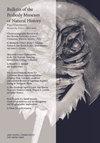Pedal Skeletal Proportions of Bipedal and Potentially Bipedal Dinosaurs and Other Archosaurs: Interpreting the Makers of Early Mesozoic Footprints
IF 0.9
4区 哲学
Q2 BIODIVERSITY CONSERVATION
引用次数: 2
Abstract
Abstract Dinosaur footprints often occur in Late Triassic–Early Jurassic continental sedimentary rocks. While many such tracks can readily be associated with the kinds of dinosaurs that made them, the makers of some footprints have been controversial. Large tridactyl (three-toed) footprints of the ichnogenus Eubrontes are thought by most paleontologists to have been made by theropod dinosaurs, but some workers think their makers were basal sauropodomorph (“prosauropod”) dinosaurs. The four-toed footprint Otozoum is usually interpreted as a prosauropod print, but some workers instead attribute it to an ornithischian (basal thyreophoran) dinosaur or even a pseudosuchian archosaur. These issues prompted us to do a new study of the proportions of the hindfeet of bipedal and potentially bipedal dinosaurs and other archosaurs, adding new measurements to previously available data. Foot skeletons of theropod dinosaurs differ from those of bipedal ornithischian dinosaurs in having relatively longer phalanges from the middle portions of toes, narrower phalanges, relatively shorter unguals, and a relatively shorter inner toe (digit I—but some members of both groups lose digit I altogether). Theropod feet differ from feet of prosauropods in having slightly narrower phalanges, relatively shorter unguals, and a relatively shorter digit I, but some smaller basal sauropodomorphs are harder to distinguish from theropods in these features. Feet of small to medium-sized ornithischians that retain digit I are very similar to those of most basal sauropodomorphs and also some pseudosuchians. Our results suggest that most (but perhaps not all) morphologically well-preserved Eubrontes are more likely to have been made by theropods than bipedal sauropodomorphs. It is more difficult to determine the most likely maker(s) of Otozoum.两足恐龙和潜在两足恐龙及其他始祖龙的踏板骨骼比例:解读中生代早期足迹的创造者
摘要恐龙足迹经常出现在三叠纪晚期-侏罗纪早期的大陆沉积岩中。虽然许多这样的足迹很容易与制造它们的恐龙种类联系在一起,但一些足迹的制造者一直存在争议。大多数古生物学家认为,Eubrontes ichnogenus的大型三叉戟(三趾)足迹是由兽脚亚目恐龙制造的,但一些研究人员认为它们的制造者是基底蜥脚类恐龙。Otozoum的四趾足迹通常被解释为原蜥脚类恐龙的足迹,但一些研究人员将其归因于鸟臀目恐龙,甚至是伪苏门长龙。这些问题促使我们对两足恐龙、可能的两足恐龙和其他始祖龙的后脚比例进行了新的研究,为之前可用的数据增加了新的测量值。兽脚亚目恐龙的脚骨架与两足鸟臀目恐龙的不同之处在于,脚趾中部的指骨相对较长,指骨较窄,有蹄类动物相对较短,内脚趾相对较短(趾I,但两组中的一些成员都失去了趾I)。兽脚类与原蜥脚类的脚不同之处在于,它们的指骨略窄,有蹄类相对较短,趾I相对较短。但一些较小的基底蜥脚类在这些特征上更难与兽脚类区分开来。保留第一指的中小型鸟臀目恐龙的脚与大多数基底蜥脚类恐龙和一些假蜥脚类动物的脚非常相似。我们的研究结果表明,大多数(但可能不是全部)形态保存完好的真龙目恐龙更有可能是由兽脚亚目恐龙而非两足蜥脚类恐龙形成的。更难确定Otozoum最有可能的制造商。
本文章由计算机程序翻译,如有差异,请以英文原文为准。
求助全文
约1分钟内获得全文
求助全文
来源期刊

Bulletin of the Peabody Museum of Natural History
BIODIVERSITY CONSERVATION-ECOLOGY
CiteScore
2.40
自引率
0.00%
发文量
6
审稿时长
>12 weeks
期刊介绍:
The Bulletin of the Peabody Museum of Natural History publishes original research based on specimens, artifacts and related materials maintained in the collections of the Yale Peabody Museum of Natural History’s curatorial divisions. The Bulletin is published twice a year, in April and October.
 求助内容:
求助内容: 应助结果提醒方式:
应助结果提醒方式:


